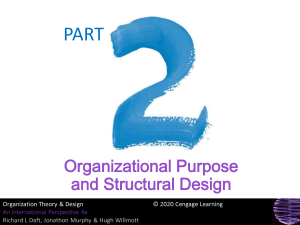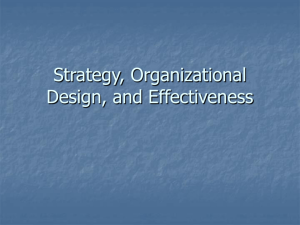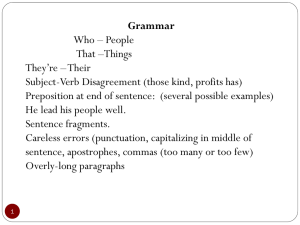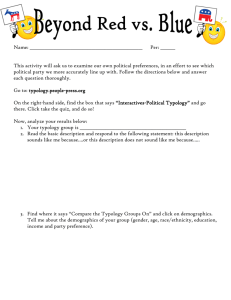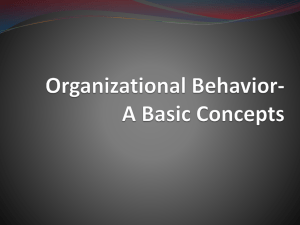投影片 1
advertisement
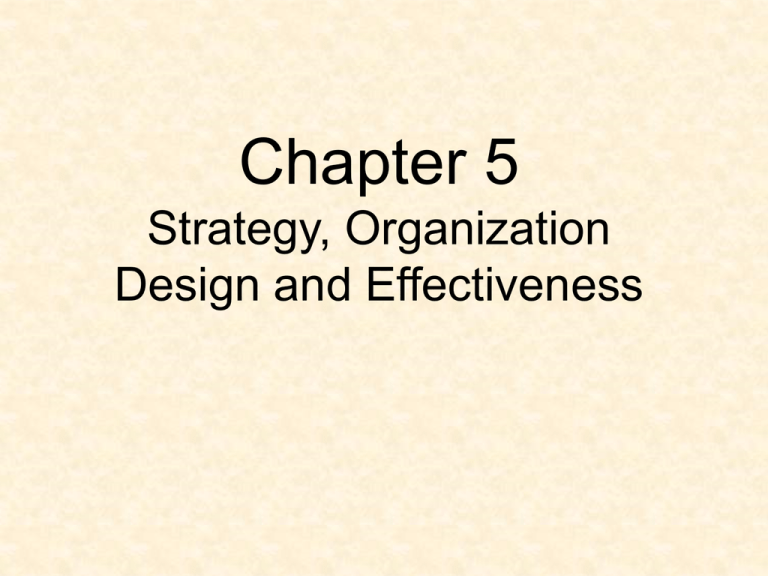
Chapter 5 Strategy, Organization Design and Effectiveness The Role of Strategic Direction in Organization Design External Environment Opportunities Threats Uncertainty Resource availability Organization Design •Structural form – Effectiveness Outcomes Strategic Direction learning vs. •Resource efficiency Define Select s CEO、 Top •Information and mission, operationa Efficiency management control systems. official l goals, Goal team •Production goals competitiv attainmen technology e t •Human resource strategies Competing policies incentives Internal Situation values •Organizational Strengths cultural Weaknesses •Interorganizational Distinctive competence linkages Leader style 圖 2.1 組織方向、設計及效能的高階管理角色 Past performance Organizational Purpose • Mission;Official goals • Operative goals Organizational Purpose Mission or Official goals Operative goals 使命 圖 2.2 賀軒公司的使命 Profitability reflects the overall performance of for-profit organization, also may be expressed in terms of net income, earnings per sharing, or return on investment. Operative Goals Overall performance Overall performance Operative Goals Resources Pertain to the acquisition of needed material and financial resources from the environment. Related to the market share or market standing desired by the organization Overall performance Operative Goals Resources Market Employee development pertains to the training, promotion, safety, and growth of employees. Overall performance Employee Development Operative Goals Resources Market Innovation goals pertain to internal flexibility and readiness to adapt to unexpected changes in the environment. Innovation Overall and change performance Operative Goals Employee Resources Development Market Productivity goals concern the amount of output achieved from available resources. Productivity Innovation Overall and change performance Operative Goals Employee Resources Development Market Goal Type and Purpose Type of goal Purpose of goals Official goals, Mission: •Legitimacy Operative goals •Employee direction and motivation •Decision guidelines •Standard of performance A Framework for Selecting Strategy and Design A strategy is a plan for interacting with the competitive environment Competitive Advantage to achieve organizational goals. Uniqueness Low cost Broad Competitive Scope Low-cost leadership Differentiation Example: Ryanair Example: Starbucks Coffee Focused low-cost leadership Narrow Example: Rent-a-Car Company 圖 2.3 Porter 競爭策略 Focused Differentiation Example: Puma Miles and Snow’s strategy typology The prospector strategy is to innovate, take risks, seek out new opportunities and grow. Prospector Miles and Snow’s strategy typology Miles and Snow’s strategy typology Prospector Defender Miles and Snow’s strategy The defender strategy is typology almost the opposite of the prospector, this strategy seeks to hold onto current customers, but it neither innovates nor seeks to grow Miles and Snow’s strategy typology Prospector Defender Miles and Snow’s strategy typology Analyzer To maintain a stable business while innovating on the periphery Miles and Snow’s strategy typology In a reactor strategy, top Defender Prospector management has not defined a long-range plan or given the organization an explicit Miles mission or goal, so the and Snow’s organization takes whatever strategy actions seem to meet typology immediate needs. Analyzer reactor 策略的組織設計結果 Contingency Factors Affecting Organization Design Technology Size/Life Cycle Culture Organizational Structure and Design The Right Mix of Design Characteristic Fits the Contingency Factors Contingency Approaches to the measurement of Organizational Effectiveness External Environment Organization Resource Input Resource-based approach Internal activities and processes Internal process approach 圖 2.5 量測組織效能的權變方法 Product and Service Outputs Goal approach Goal Approach Indicators The important goals to consider are operative goals. Efforts to measure effectiveness have been more productive using official goals. usefulness Business firms typically evaluate performance in terms of profitability, growth, market share, and return on Investment. Resource-based Approach Indicators Obtaining and successfully managing resources is the criterion by which organizational effectiveness is assessed. usefulness The resource-based approach is valuable when other indicators of performance are difficult to obtain. Internal Process Approach Indicators One indicator of internal process effectiveness is the organization’s economic efficiency. There are seven ․Strong corporate culture and positive work climate of an effective organization as ․Teamindicators spirit, group loyalty, and teamwork ․Confidence, trust, and communication between workers and management seen from an internal process approach: ․Decision making near sources of information, regardless, of where those sources are on the organizational chart ․Undistorted horizontal and vertical communication; sharing of relevant facts and feelings ․Rewards to managers for performance, growth, and development of Subordinates and for creating an effective work group ․Interaction between the organization and its parts, with conflict that occurs over projects resolved in the interest of the organization Internal Process Approach usefulness The internal process approach is important because the efficient use of resources and harmonious internal functioning are ways to asses organizational effectiveness. An Integrated Effectiveness Model • The model is based on the assumption that there are disagreements and competing viewpoints about what constitutes effectiveness. Open systems model A combination of external focus and flexible structure Leads to an open system model. Primary goal: growth and resource acquisition. Rational goal model Represents management values of structural control and external focus. The primary goals are productivity, efficiency, and profit. An Integrated Effectiveness Model Internal process model Its reflects the values of internal focus and structural control. The primary outcome is a Stable organizational setting that maintains itself In an orderly way. Human relations model Its incorporates the values of an internal focus and Flexible structure. Management concern is for the development of human resources. Structure Flexibility Open Systems Emphasis Human Relations Emphasis Focus Internal Internal Process Organizational A Organizational B Emphasis External Rational Goal Emphasis Control 圖 2.7 Effectiveness Values for two organizations
